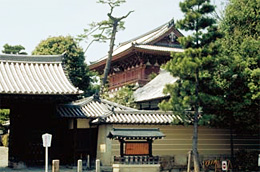
Daitoku-ji Temple is also called “Mt.Ryuho-zan” (Dragon Treasure Mountain), and is a living center for the transmission and practice of Zen Buddhism. It is a large complex of functioning Zen temples, almost like a small village. Each sub-temple has its own charms, and many are open to the public so that visitors can explore their graceful gardens, tea rooms, and other special treasures.
Founded in 1315, the original buildings of Daitoku-ji Temple were lost to fire during the Onin War in the 15th century. In later years the famous Zen priest Ikkyu, well-known for his poetry and eccentric style, began to restore the temple and received donations of land and buildings, causing the temple to prosper. This is demonstrated in its architecture: the imposing main gate, main lecture hall, and main worship hall are all Important Cultural Properties. Several sub-temples are famous for their spectacular gardens. Notable among these are Koto-in (famous for its maples in autumn) and Daisen-in Temple (please see our separate entry for the most famous of these sub-temples, Daisen-in Temple).
A famous incident involving the master of the tea ceremony, Sen-no-Rikyu, took place at Daitoku-ji Temple in 1591. According to one version of the story, Rikyu was involved in a dispute with his main patron, the warlord Hideyoshi Toyotomi. He had a statue of himself placed on the main gate of Daitoku-ji Temple. When Hideyoshi entered the temple, he did so by passing under the statue of Rikyu (i.e. by lowering himself before Rikyu). On learning of this, Hideyoshi flew into a rage, and demanded that Rikyu commit suicide. Doing so was Rikyu’s way to maintain his dignity while not yielding to his political master. Once per year, on the anniversary of his death, tea ceremonies are held throughout the temple complex. Kimono-clad women can also been seen throughout the grounds on this day.
Basic Information
- Address : 53 Murasakino Daitokuji-cho, Kita-ku, Kyoto-shi, 603-8231
- Website : Click here




